Day 3 Sunday Nov 26 Saqqara, Dahshur Necropolis, Memphis museum
We reminded Mohamed on whatsapp re our
agreement to drive us to the pyramids and tombs at Saqqara and Dahshur and he was at our door by 7 am. He took us to Dahshur 1st
as it's furthest away.
Dahshur Necropolis
Dahshur is an ancient royal necropolis located roughly 40 kilometer (25 miles) from Cairo. the two oldest pyramids in the country are found at this necropolis.
Red Pyramid
The Red Pyramid, also called the North Pyramid, is the largest of the pyramids located at the Dahshur necropolis . Named for the rusty reddish hue of its red limestone stones, it is also the third largest Egyptian pyramid, after those of Khufu and Khafre at Giza.
It is Egypt's first successful attempt at constructing a "true" smooth-sided pyramid.The Red Pyramid was the third pyramid built by Old Kingdom Pharaoh Sneferu, and was built 2575–2551 BCE.
The Red Pyramid is located approximately one kilometre (0.62 mi) to the north of the Bent Pyramid. It is built at the same shallow 43 degree angle as the upper section of the Bent Pyramid [its design may be an outcome of engineering crises experienced during the construction of Sneferu's two earlier pyramids. The first of these, the Pyramid at Meidum, collapsed in antiquity, while the second, the Bent Pyramid, had the angle of its inclination dramatically altered from 54 to 43 degrees part-way through construction.
the later Red Pyramid was at an inclination known to be less susceptible to instability and therefore less susceptible to catastrophic collapse]
The Red Pyramid was not always red. It used to be cased with white Tura limestone, but only a few of these stones now remain at the pyramid's base, at the corner
We decided not to climb in because of
the bat smell, Local residents refer to the Red Pyramid as el-heram el-watwaat, meaning the Bat Pyramid [Musty, bat shit smell inside]
We drove on to Bent pyramid
BENT PYRAMID
the Meidum pyramid was probably the first attempt at building a smooth-sided pyramid, and it collapsed when construction of the Bent Pyramid was already well under way – and the Bent pyramid also begun to show alarming signs of instability itself, as evident by the presence of large timber beams supporting its inner chambers. The outcome of this was the change in inclination of the Bent Pyramid as seen here
we attempted to go inside the Bent pyramid... climbed up these steps
at the entrance to the pyramid ...the pyramid guardian checked our ticket/cairo pass and took this pic. We tipped him 10egp [30.9 egp=1usd]
it is a low sloping passage where we bent our heads and went forward
the passage became still further low... we had to bend double as seen below
we decided to turn back.
Drove a little further, saw the White pyramid which looks a pile of rubble now. The Black pyramid is too unsafe to visit.
We drove to the Memphis museum
MEMPHIS MUSEUM
Memphis was the oldest capital of ancient Egypt, founded after the unification of upper and Lower Egypt by the first dynasty (3100 BC)
Today, almost all of Memphis lies in ruins beneath the modern village and farmland of Mit Rahina. However, there is ongoing archaeological digging and a well-done Open Air Museum that provides a taste of the relics.
Limestone colossus of king Ramses II 1305-1237 BC
A Genoese traveler found it in 1820 face down and partially buried in a swampy area. Missing its legs, it lies face up now. [Ramses II ruled for 66 years, fathered 90 children, built several monuments for himself]
Alabaster sphinx
This is the Sphinx an 80 ton alabaster statue of Amenophis II discovered in 1912.
This is where the temple of Ptah was located, Ptah was worshipped as the creator god, and his wife is the lion headed Sekhmet and their son is Nefertum.
This is the sculpture of the Divine Triad, with Ramses II portraying himself as Nefertum!!
Striding Ramses II
colorful souvenirs...

We then drove on to Saqqara. There was a long line buying tickets. We drove past the kiosk as we had Cairo pass. The guards said we had to stand in the line and buy parking ticket which will be issued only by credit card payment.
Our driver decided to drive to the parking spot and let us carry on with our pyramid/ tomb visits. He said he'll buy the ticket with cash if anybody comes over to check.
SAQQARA NECROPOLIS:
The necropolis of Saqqara is the largest group of Egyptian tombs of antiquity. The site was a necropolis from the 1st Dynasty, and during the whole of the old empire, with periods of abandonment, before being updated again during the New Kingdom.
Saqqara is about 15 km south of the Giza Necropolis, facing the city of Memphis. It is bordered by the necropolis of Dahshur in the South, located on the west bank of the Nile, like most of the necropolises of ancient Egypt [death being associated with the setting sun].
Saqqara is the place of burial of the first pharaohs, those of the first three dynasties. At the time they were buried in mastabas.
archaic tombs are simple excavations in which the deceased was buried in a fetal position and wrapped in a reed mat.
Mastabas are rectangular-looking mounds with sloped walls . They generally consist of two parts: The chapel, where the funerary cult was celebrated, and the vault, in which the deceased was buried .
Pharaoh Djoser's was the first to be built a pyramid, the famous step pyramid of Djoser.
STEP PYRAMID/ Djoser
This Saqqara pyramid is from the 3rd dynasty, so it was the first of this area. THIS IS BASICALLY several mastabas of decreasing size stacked.
The funerary complex:


we went round the whole pyramid, saw a gate at the north entrance but it was locked. A guide came up with his client and was explaining the details. We asked him if this is the entrance which is supposed to be open. He confirmed. They left, we waited for a few more minutes but had to leave as well. We were disappointed we could not go into the Step pyramid.
The guardian may have come in late and opened it but we did not go back to check
Unas tomb

a crouched descent into the tomb is well rewarded
Unas tomb is the
first in history to have religious texts (Pyramid Texts) on the walls of its burial chamber.saw many awesome tombs...with amazing raised relief work
fishing
False door near where the sarcophagus lies...it's supposed to lead to the other world
False door in another tomb

hieroglyphics on the outer wall of a tomb
amazing raised relief
the little details of toe nails, hair etc sharply etched and the pigment fresh as ever...
SERAPEUM

Serapeum (from the time of Amenhotep III in the New Kingdom through to the Ptolemaic Period ) has the tombs that once housed the mummified remains of the sacred Apis bulls that were associated with the god Ptah, whose cult center was in Memphis.
Priests selected certain bulls based on their markings and divine birth. The bulls were treated with a lot of privilege during their life. Upon death, the bulls were mummified and placed in sarcophagi in an elaborate celebration.
Inscriptions record many kings who made offerings in the Serapeum. Two sons of Ramses II, Khaem-waset and Meren-ptah, donated several bulls, jewelry and shabtis as princes and High Priests of Ptah
the Serapeum is composed of two long corridors. 24 sarcophagi remain in the Greater Vaults. The oldest dates to the last great native ruler Amasis II, around 550 BC. The final was made some 500 years later, during the reign of the first Roman emperor Augustus.
Most are over 2 metres (6.6 ft) in width and height and almost twice as long. They weigh around 40 tonnes (88,000 lb), excluding their lids which are about half as heavy.
The winches, rollers and rails found in the Serapeum might have been used to transport the stones through the narrow tunnels. The sarcophagi were lowered into their final position by removing sand the burial chambers were filled with beforehand. All surviving coffers are made out of "costly stone" (granite, basalt, diorite, etc.)
False door
false door
Descent into tomb of Teti... an amazing tomb

Day 4 report continues here:






















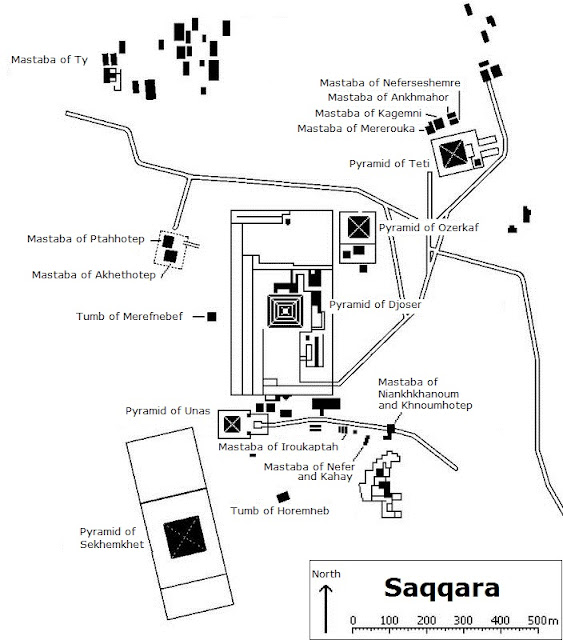







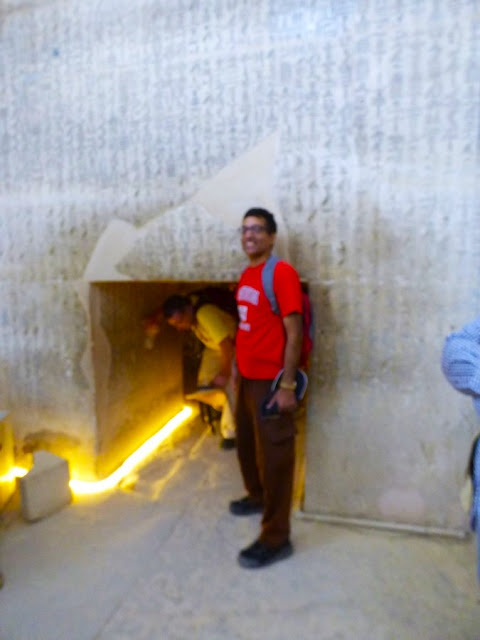

















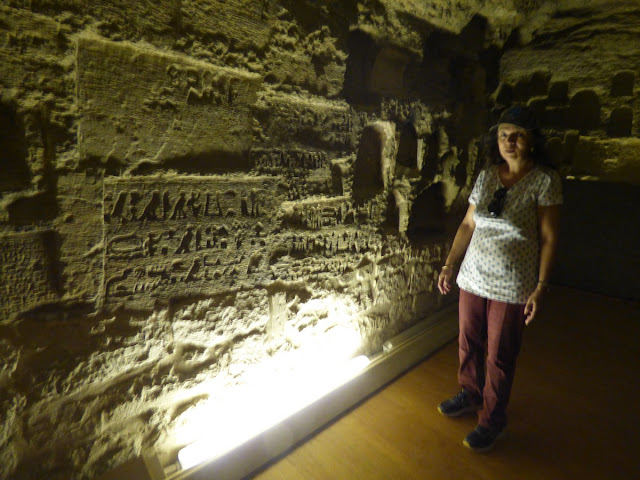
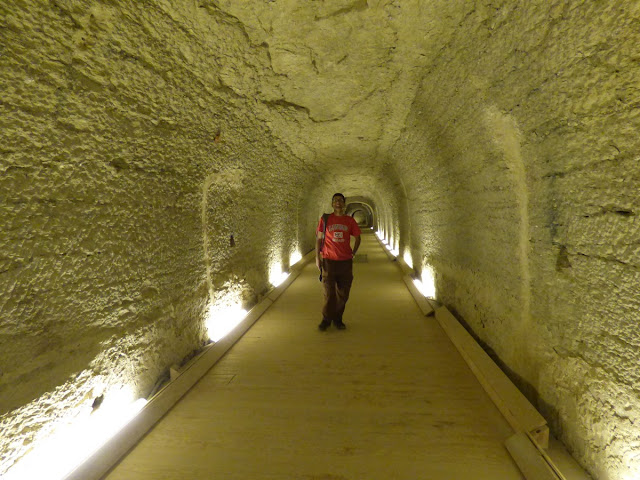

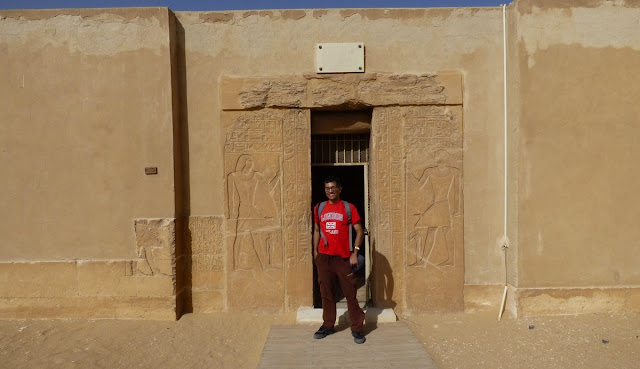



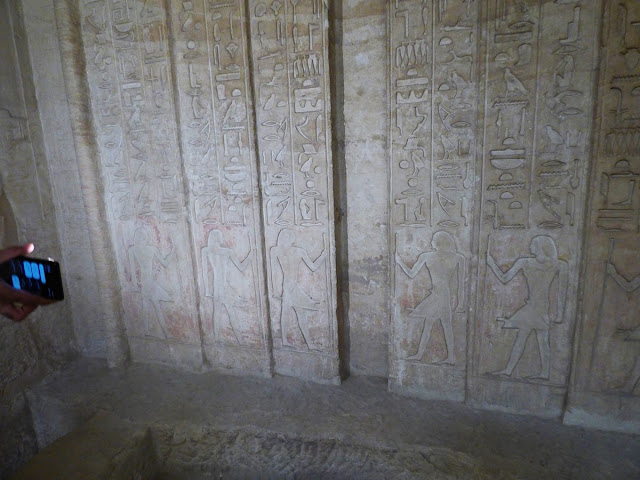





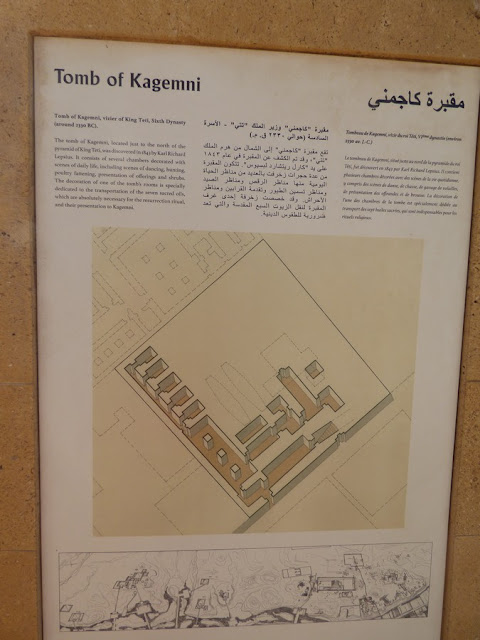






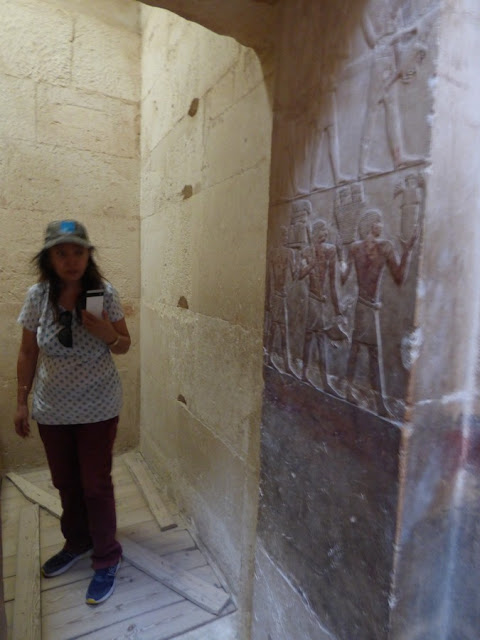









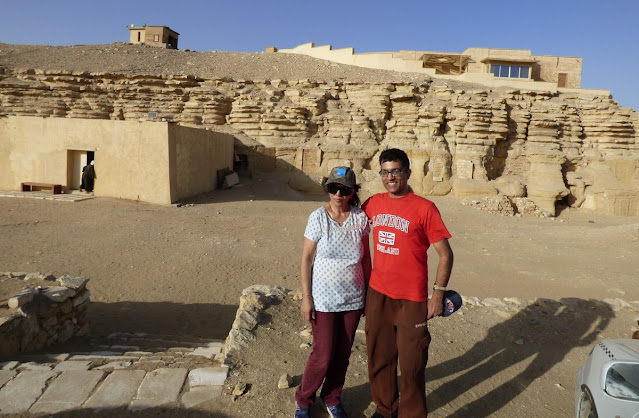
No comments:
Post a Comment